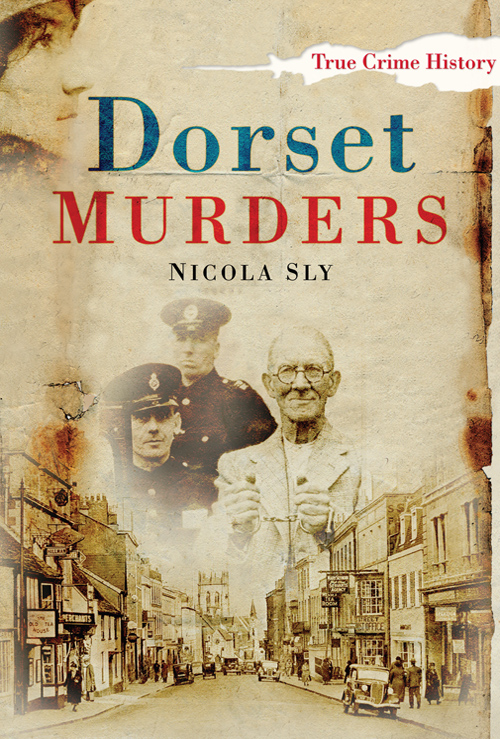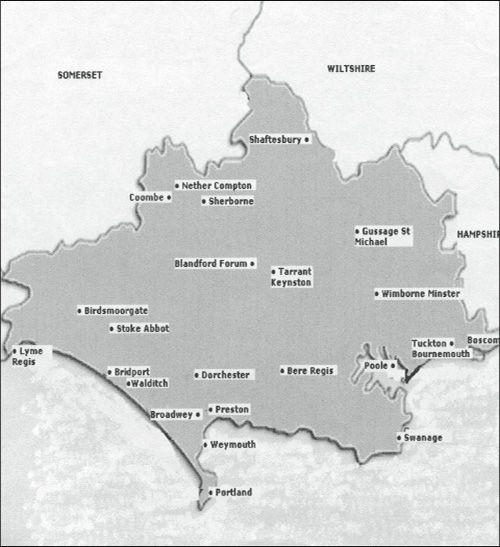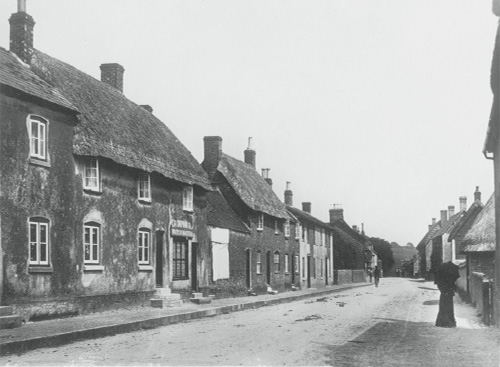Dorset Murders


M
URDERS
N
ICOLA
S
LY
Â
Â


Map of Dorset
.
First published 2008
The History Press
The Mill, Brimscombe Port
Stroud, Gloucestershire,
GL
5 2
QG
This ebook edition first published in 2012
All rights reserved
© Nicola Sly, 2011, 2012
The right of Nicola Sly,, to be identified as the Author of this work has been asserted in accordance with the Copyrights, Designs and Patents Act 1988.
This ebook is copyright material and must not be copied, reproduced, transferred, distributed, leased, licensed or publicly performed or used in any way except as specifically permitted in writing by the publishers, as allowed under the terms and conditions under which it was purchased or as strictly permitted by applicable copyright law. Any unauthorised distribution or use of this text may be a direct infringement of the author's and publisher's rights and those responsible may be liable in law accordingly.
EPUB ISBN
978 0 7524 8391 7
MOBI ISBN
978 0 7524 8390 0
Original typesetting by The History Press
Author's Note & Acknowledgements
1. âI will be damned if I know her a man from a woman'
2. âThe horse have kicked poor John and killed 'ee'
3. âI fancied it was a sort of deathly scream'
4. âIf you bide there chafing me, I'll get up and beat thee brains out'
5. âSee what comes of annoying a nervous man'
6. âI did the act, but not intentionally, sir'
Portland Convict Prison, 1863â1870
7. âI hope they will prove that I did it'
8. âI tried to settle one last leave and I have succeeded this time'
9. âThis is all through men going to my house while I'm away'
10. âI don't want anything else to do with you, Mr Simmons'
11. âGod bless you and keep you, dearie'
12. âShe doesn't want any money where she is to'
13. âI am innocent of this crime â absolutely'
14. âYou wouldn't cheat me, would you?'
15. âMy head feels awful queer'
16. âI will have you all, one at a time'
17. âI have felt that someone, somewhere, knows something'
18. âI did it deliberately and I'd do it again'
19. âI've been a good wife to him and nobody can say I haven't'
20. âEveryone will be astounded'
21. âThis is my night to howl'
22. âPut me down as not guilty, old boy'
W
hen I was asked to compile a collection of Dorset murders, I was instantly faced with a dilemma â what to do about Bournemouth? Prior to boundary changes in 1974, Bournemouth was located in Hampshire and, since all the murders in this selection occurred before this date, five of those included in this book were technically committed in Hampshire rather than in Dorset. In the end it was the cases themselves which swayed my decision to write about the county of Dorset as it is today. Four of the cases were nationally notorious and the fifth â the story of the Wright family â was one of the most tragic I have ever come across in an almost thirty-year-long study of murder.
Thus the murders of Emma Sherriff in 1908, Irene Wilkins in 1921 and Francis Rattenbury in 1935 are included, as are the infamous crimes of Neville Heath, which took place in both London and Bournemouth. They join a diverse collection of murders committed for financial gain, for revenge, or for ridding the killer of a partner who, for one reason or another, had simply become a nuisance. Some of the murders can be attributed to the insanity of the killer, while others, such as the mysterious murder at the Coverdale Kennels, remain unsolved to this day.
There are numerous people who must be acknowledged and thanked for their assistance in compiling this collection. John J. Eddleston, Roger Guttridge and Theresa Murphy have all previously published books either on murder in Dorset or more general reference works on British murders and executions. The memoirs of J.D. Casswell QC, who defended or prosecuted some of the accused, provided a fascinating behind-the-scenes insight into their cases, while Douglas Browne and E.V. Tullett's book on the life and cases of Sir Bernard Spilsbury gave a new depth to the meticulous work of the celebrated pathologist. These books are recorded in more detail in the bibliography, as are the local and national newspapers, which proved an invaluable source of material. My thanks must also go to the staff of the Dorset History Centre for their help in my research and to the
Daily Echo,
Bournemouth, for permission to use photographs from their archives.
I must also thank John Van der Kiste and, of course, my husband, Richard, without whom this book could not have been written. His suggestions for improving each chapter were invaluable, as was his help with the photography. Both he and my father, John Higginson, have supported me from the first word of this book to the last.
Finally, my thanks must go to my editor at The History Press, Matilda Richards, for her continued help and encouragement.
âI WILL BE DAMNED IF I KNOW HER A MAN FROM A WOMAN'


A
t about 10 p.m. on 14 May 1818, Ann Loveridge was standing on her front doorstep taking a breath of fresh air when she suddenly heard a woman's voice cry out, âOh! The Lord have mercy on me!' A low groan followed, then silence. Ann called out to her next-door neighbour, Elizabeth Rose, to ask if she had heard anything, but she hadn't.
The noises had seemed to come from the direction of the home of another neighbour, Priscilla Brown, who lived with her eight-year-old son Charles in a cottage some twenty yards away. Ann Loveridge had a quick look around the area but saw nothing out of the ordinary.
An hour later, labourer Robert Lane was walking down Back Lane, the small road that ran behind Priscilla Brown's cottage, when he spotted a woman he recognised as Priscilla lying on her back on a dung heap. Thinking that she may have had a seizure, he spoke to her three times. Having received no response, he placed his hand on her breast to see if he could detect a heartbeat and, when he could find none, he ran to get help.
The first people to arrive on the scene were Priscilla's brother and a neighbour, Henry Philips. Between them, the men carried Priscilla back to her house, still unsure of whether she was dead or just unconscious. A doctor was summoned, but by the time Dr Thomas Nott arrived at 1 a.m. on the morning of 15 May, they had all realised that it was the former.

West Street, Bere Regis, 1920s
.
There were a number of people milling about Priscilla's small cottage by then and the doctor was only able to give the body a cursory examination, at which he noted that the woman's throat was blackened and that she had marks around her mouth and nose. Dr Nott came to the conclusion that the woman had been strangled, but when he was able to conduct a more detailed post-mortem examination later that morning, during which he opened the body and head of the victim, he realised that the cause of death had been suffocation rather than strangulation. It seemed as though someone had obstructed Priscilla Brown's nose and mouth, probably with a hand, and prevented her from breathing. Dr Nott also confirmed that Brown was between six and seven months pregnant.